Researchers follow path of sediments from mountains and glaciers to the deep sea.-
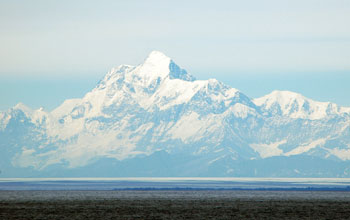
Alaska's Malaspina Glacier, visible in the foreground, spreads over the land as it 'flows.'
Credit: John Jaeger
Download the high-resolution JPG version of the image. (4.7 MB)
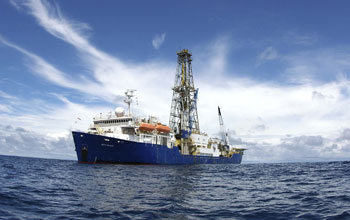
The scientific drilling vessel JOIDES Resolution is on an expedition in the Gulf of Alaska.
Credit: IODP
Download the high-resolution JPG version of the image. (464 KB)
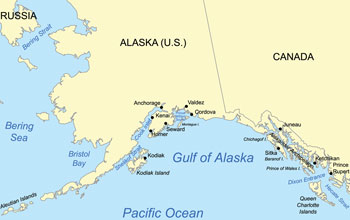
Map of the Gulf of Alaska, where IODP Expedition 341 is taking place.
Credit: Wikimedia Commons
Download the high-resolution PNG version of the image. (282 KB)
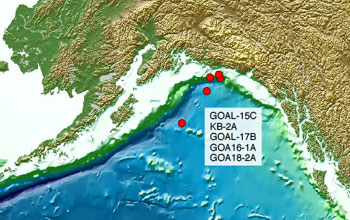
Sites marked in red show where scientists plan to retrieve sediment core samples.
Credit: IODP
Download the high-resolution JPG version of the image. (168 KB)
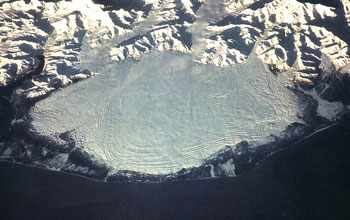
Malaspina Glacier (from space) is a piedmont glacier: it's along the foot of a mountain range.
Credit: NASA
Download the high-resolution JPG version of the image. (176 KB)
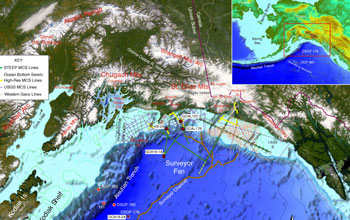
Location of current drilling sites on IODP Expedition 341, and previous drilling sites (inset).
Credit: IODP
Download the high-resolution JPG version of the image. (420 KB)
Geologists aboard the scientific ocean drilling vessel JOIDES Resolution
have embarked on their next adventure: studying glaciers to learn how
Earth's geologic processes relate to the planet's climate history.
In
the waters near Alaska's stunning coastal glaciers, the researchers are
on Integrated Ocean Drilling Program (IODP) Expedition 341: Southern
Alaska Margin Tectonics, Climate and Sedimentation.
The ship set sail today from Victoria, British Columbia. The expedition will conclude on July 29, 2013.
"Its
scientists are examining the relationship between mountain-building,
glaciation and climate," says Jamie Allan, program director in the U.S.
National Science Foundation's (NSF) Division of Ocean Sciences, which
supports IODP.
"This interplay happens not only in Alaska but in
other parts of the world," says Allan. "New insights into these
processes will help scientists better understand climate history and
change, and how mountain landscapes form."
Led by co-chief
scientists John Jaeger of the University of Florida and Sean Gulick of
the University of Texas at Austin, an international team of researchers
will collect and study sediments from five locations in the Gulf of
Alaska.
They will investigate interactions between long-term
climate change, including the fluctuations of large glaciers, and how
mountains form.
The geologists will also conduct research on the transport of sediments from the mountains to the deep sea.
Because glaciers can erode and carry with them large amounts of rock, these rivers of ice can dramatically alter the landscape.
By
rapidly decreasing the overall amount of rock in areas they scour,
glaciers can also alter mountain ranges and cause uplifting--sometimes
in less than one million years. In geologic terms, a relatively short
time span.
"Mountains grow when numerous faults thrust layers of
rock on top of each other," Gulick says. "We're asking whether this
increases in locations with lots of erosion, such as beneath Alaska's
glaciers."
The mountains of southern Alaska "have the perfect
combination of large glaciers and rapidly uplifting mountains to test
this idea," says Jaeger.
"We know very little about the long-term
history of these glaciers," he says, "relative to what we know about
other large ice sheets in, for example, Greenland and Antarctica."
The
scientists are also comparing the advance and retreat of the Northern
Cordilleran Ice Sheet with those of other major ice sheets. During the
last 2.6 or so million years, the Cordilleran Ice Sheet periodically
covered a large part of North America.
They also plan to obtain a
record of Earth's magnetic field reversals recorded in the Gulf of
Alaska, and look at ocean circulation changes and their effects on
Earth's carbon cycle during transitions into and out of ice ages.
"Thousands
of tourists sail through the Gulf of Alaska each year to see the
dramatic landscapes created by these glaciers," Jaeger says.
Jaeger
hopes that, in addition to many scientific benefits, "the findings from
this expedition will provide tourists with a sense of how dynamic that
landscape truly is."
The Integrated Ocean Drilling Program (IODP)
is an international research program dedicated to advancing scientific
understanding of the Earth through drilling, coring and monitoring the
subseafloor.
The JOIDES Resolution is a scientific
research vessel managed by the U.S. Implementing Organization of IODP
(USIO). Texas A&M University, Lamont-Doherty Earth Observatory of
Columbia University and the Consortium for Ocean Leadership comprise the
USIO.
IODP is supported by two lead agencies: the U.S. National
Science Foundation and Japan's Ministry of Education, Culture, Sports,
Science and Technology.
Additional program support comes from the
European Consortium for Ocean Research Drilling, the Australia-New
Zealand IODP Consortium, India's Ministry of Earth Sciences, the
People's Republic of China's Ministry of Science and Technology, the
Korea Institute of Geoscience and Mineral Resources and Brazil's
Ministry of Education.
-NSF-
Media Contacts
Cheryl Dybas, NSF (703) 292-7734 cdybas@nsf.gov
Matt Wright, Consortium for Ocean Leadership (202) 448-1254 mwright@oceanleadership.org
Miyuki Otomo, IODP (+81) 367013188 motomo@iodp.org
Matt Wright, Consortium for Ocean Leadership (202) 448-1254 mwright@oceanleadership.org
Miyuki Otomo, IODP (+81) 367013188 motomo@iodp.org
Related WebsitesIODP Expedition 341: Southern Alaska Margin Tectonics, Climate and Sedimentation: http://iodp.tamu.edu/scienceops/expeditions/alaska_tectonics_climate.html
The National Science Foundation (NSF) is an independent federal
agency that supports fundamental research and education across all
fields of science and engineering. In fiscal year (FY) 2012, its budget
was $7.0 billion. NSF funds reach all 50 states through grants to nearly
2,000 colleges, universities and other institutions. Each year, NSF
receives about 50,000 competitive requests for funding, and makes about
11,500 new funding awards. NSF also awards about $593 million in
professional and service contracts yearly.
Useful NSF Web Sites:
NSF Home Page: http://www.nsf.gov
NSF News: http://www.nsf.gov/news/
For the News Media: http://www.nsf.gov/news/newsroom.jsp
Science and Engineering Statistics: http://www.nsf.gov/statistics/
Awards Searches: http://www.nsf.gov/awardsearch/
The National Science Foundation (NSF)NSF Home Page: http://www.nsf.gov
NSF News: http://www.nsf.gov/news/
For the News Media: http://www.nsf.gov/news/newsroom.jsp
Science and Engineering Statistics: http://www.nsf.gov/statistics/
Awards Searches: http://www.nsf.gov/awardsearch/
Guillermo Gonzalo Sánchez Achutegui
ayabaca@gmail.com
ayabaca@hotmail.com
ayabaca@yahoo.com
No hay comentarios:
Publicar un comentario